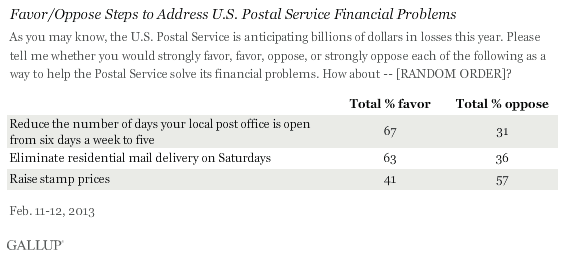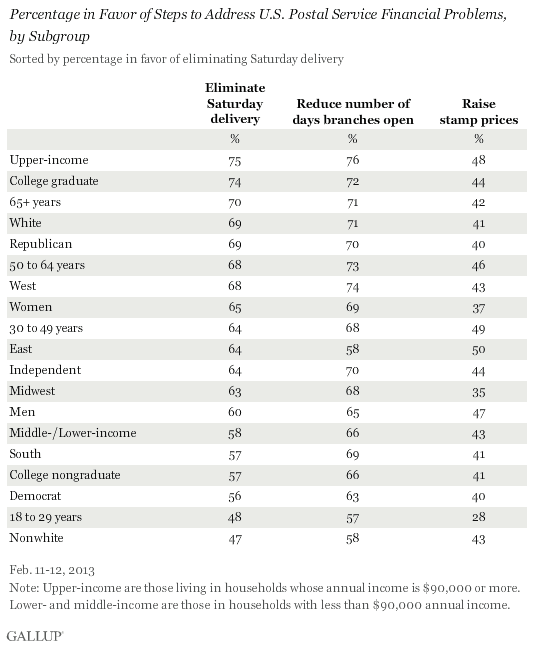PRINCETON, NJ -- Sixty-three percent of Americans say they favor ending Saturday residential mail delivery as a way for the U.S. Postal Service to address its financial problems. A similar majority also favor reducing the number of days local post office branches are open. A majority oppose raising stamp prices.

The postmaster general testified before Congress on Wednesday about the Postal Service's plans to eliminate Saturday mail delivery starting in August, to save roughly $2 billion a year. It is unclear whether Congress must approve that action.
Gallup has asked about possible solutions to the Postal Service's financial woes previously -- in 2009 and 2010 -- and has consistently found majority support for reducing the number of days mail is delivered, regardless of the precise question wording. Previous versions of the question on reducing mail delivery days did not specify elimination of Saturday mail delivery, as the Postal Service is now proposing.
Majorities have also favored reducing the number of days post offices are open, while a majority has consistently opposed increases in stamp prices. In January, the post office raised the price of a stamp for a first-class letter to 46 cents, the third increase in three years.
Young Adults and Nonwhites Least Supportive of Eliminating Saturday Delivery
Most members of major U.S. subgroups support the elimination of Saturday residential mail delivery. The two exceptions are young adults and nonwhites, who are divided in their opinions. People of higher socioeconomic status -- including upper-income adults and those with more formal education -- are the groups most likely to support ending Saturday delivery.
While majorities of all partisan groups favor ending Saturday delivery, Republicans (69%) show higher support for this than Democrats (56%).

The demographic patterns of support for reducing the number of days post office branches are open are similar to those for ending Saturday delivery. Upper-income (76%) and college-educated Americans (72%) are also among the groups most likely to support reducing the number of days post office branches are open, while nonwhites (58%) and young adults (57%) are among the groups least likely to support such a step.
Between 40% and 50% of most subgroups favor raising stamp prices. One notable exception is young adults, 28% of whom support increasing the cost of stamps.
Implications
The proposal to end Saturday residential mail delivery is not a new one, but the U.S. Postal Service hopes to move forward with the change this August. The American public seems to back the move, and in fact has for some time supported a one-day reduction in the number of days mail is delivered each week as a way to help the U.S. Postal Service solve its financial issues.
Whether Saturday mail delivery ends in August as planned may ultimately depend on legal questions over whether Congress must approve the move and, if so, whether Congress actually does approve it.
Survey Methods
Results for this Gallup poll are based on telephone interviews conducted Feb. 11-12, 2013, on the Gallup Daily tracking survey, with a random sample of 1,025 adults, aged 18 and older, living in all 50 U.S. states and the District of Columbia.
For results based on the total sample of national adults, one can say with 95% confidence that the margin of sampling error is ±4 percentage points.
Interviews are conducted with respondents on landline telephones and cellular phones, with interviews conducted in Spanish for respondents who are primarily Spanish-speaking. Each sample of national adults includes a minimum quota of 50% cell phone respondents and 50% landline respondents, with additional minimum quotas by region. Landline telephone numbers are chosen at random among listed telephone numbers. Cell phones numbers are selected using random digit dial methods. Landline respondents are chosen at random within each household on the basis of which member had the most recent birthday.
Samples are weighted to correct for unequal selection probability, nonresponse, and double coverage of landline and cell users in the two sampling frames. They are also weighted to match the national demographics of gender, age, race, Hispanic ethnicity, education, region, population density, and phone status (cellphone only/landline only/both, cellphone mostly, and having an unlisted landline number). Demographic weighting targets are based on the March 2012 Current Population Survey figures for the aged 18 and older U.S. population. Phone status targets are based on the July-December 2011 National Health Interview Survey. Population density targets are based on the 2010 census. All reported margins of sampling error include the computed design effects for weighting.
In addition to sampling error, question wording and practical difficulties in conducting surveys can introduce error or bias into the findings of public opinion polls.
View methodology, full question results, and trend data.
For more details on Gallup's polling methodology, visit www.gallup.com.
